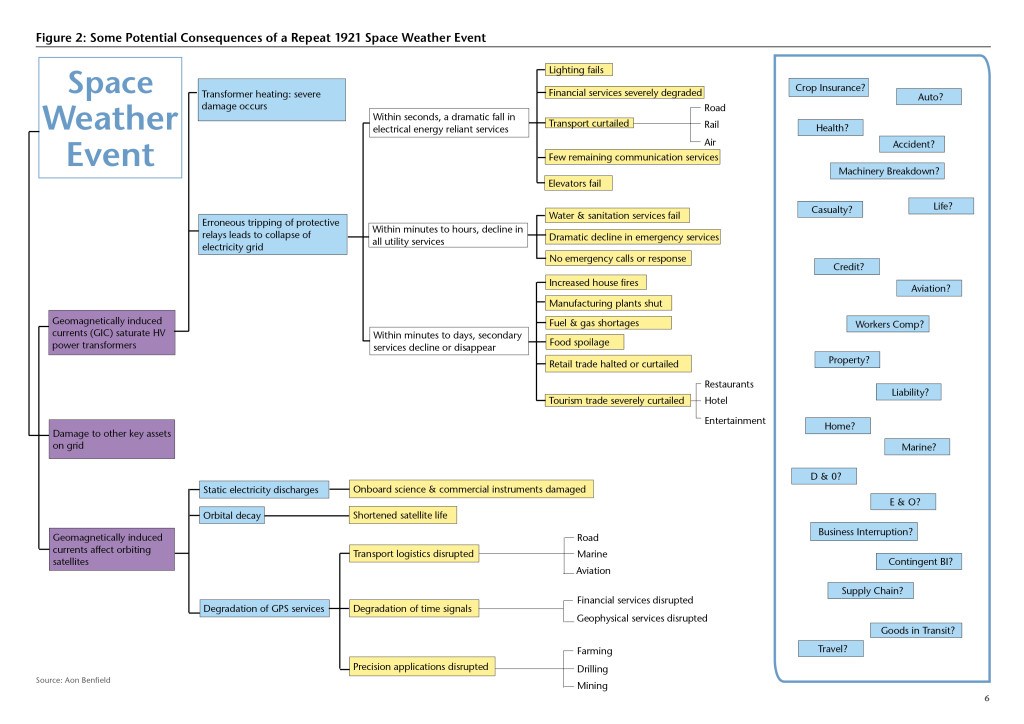Solar and geomagnetic activity is expected to peak this year, increasing the possibility of disruption to government and private infrastructure.
According to Rade Musulin, COO Aon Benfield Analytics Asia Pacific, following an 11 year cycle, the peak in solar activity could affect and/or disable three areas of our infrastructure: electrical power distribution, telecommunications and global satellite navigation.
Earlier this year, Aon Benfield launched a new geomagnetic storm report to assist the insurance industry in assessing the ramifications of a severe space weather event.
Musulin said that while peak sun spot activity will likely occur in the third quarter of 2013, that doesn’t mean disruption will be noticeable.
“Increased solar activity makes extreme solar weather more likely this year, that doesn’t necessarily make it more severe, “according to Musulin.
The increase in solar activity could lead to massive electrical currents called geomagnetically induced currents (GICs), which flow through the earth causing enhanced noise and increased radiation.
The noise interferes with electromagnetic signals which can disrupt global telecommunications, both ground-based and through satellites, he said.
In addition, enhanced solar radiation can become trapped in radiation belts around the earth, impacting satellite systems.
He said the increased solar activity could also lead to loss of time signals from satellites which could affect banks, ATMs and GPS systems.
“Our society today has become incredibly dependent upon countless technologically advanced tools; examples include navigation devices in your car, electricity, the internet. All of these things could be at risk from a large geomagnetic storm,” said Musulin.
Potential damage to electrical grids as a result of surges is a possibility, said Musulin, citing the example of the Quebec power failure in 1989. Hydro-Quebec’s power grid, which serviced the Canada province, failed as a result of the strongest magnetic storm documented during that time.
A massive power failure could shut down lighting, heating, utilities, communications, transport, emergency services or retail trade, he said.
GICs could ruin several transformers.
The massive electrical currents flowing through earth could result in power failures to a wide area which could lead to a large scale blackouts or permanent damage to transformers. Transformers, which step up or down power on major supply lines, could take a long time to repair or replace, Musulin said.
“A few spares [transformers] are available and each one is generally purpose built to the particular electrical grid it’s in,” he said.
Considering that transformers are large, sophisticated pieces of equipment the size of a house and cost millions of dollars, each could take up to a year to build, according to Musulin. The global manufacturing capacity is only about 70 transformers a year, he said.

While these types of solar weather events may not be on an underwriter’s radar, there will likely be some coverage for damage resulting from them.
“The reality is that the economic consequences of a large geomagnetic event would to some degree be cushioned by various insurance coverages,” he said.
To date, Musulin said that there have been few attempts by the industry to estimate the cost of space weather events in a systematic manner. If a repeat of an 1859 severe geomagnetic storm, dubbed the Carrington event, occurred now it could cost $2 trillion to the U.S. alone, according to the U.S. National Academy of Sciences, and that’s just for the first four years of recovery which could take up to a decade.
Listen to the entire interview.
Was this article valuable?
Here are more articles you may enjoy.

 Smartmatic, One America News Settle Election Defamation Lawsuit
Smartmatic, One America News Settle Election Defamation Lawsuit  California Sees Two More Property Insurers Withdraw From Market
California Sees Two More Property Insurers Withdraw From Market  Beyond the Claim: How Social Canvassing is Transforming Insurance Fraud Detection
Beyond the Claim: How Social Canvassing is Transforming Insurance Fraud Detection  Poll: Consumers OK with AI in P/C Insurance, but Not So Much for Claims and Underwriting
Poll: Consumers OK with AI in P/C Insurance, but Not So Much for Claims and Underwriting 